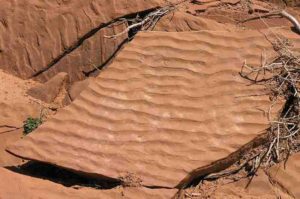
Ripple marks are sedimentary structures and indicate agitation by water (current or waves) or wind.
Ripple marks are ridges of sediment that form in response to wind blowing along a layer of sediment. They are form perpendicular to the wind direction and each ridge is roughly equidistant from the ripple mark on either side.
The troughs and ridges of fossilized ripple mark in sandstone and siltstones are hardened versions of the short-lived ripples in the loose sand of a modern-day stream, lake, sea, or sand dune. Ripples may be made by water or, in sand dunes, by wind. The symmetry of water-current ripple marks indicate whether they were formed by gentle waves or faster water currents.
What are types of Ripple marks?
There are two types:
Symmetrical ripple marks
Often found on beaches, they are created by a two way current, for example the waves on a beach (swash and backwash). This creates ripple marks with pointed crests and rounded troughs, which aren’t inclined more to a certain direction. Three common sedimentary structures that are created by these processes are herringbone cross-stratification, flaser bedding, and interference ripples.
Asymmetrical ripple marks
These are created by a one way current, for example in a river, or the wind in a desert. This creates ripple marks with still pointed crests and rounded troughs, but which are inclined more strongly in the direction of the current. For this reason, they can be used as palaeocurrent indicators.
Ripple marks Size (scale)
- Very small: Very small cross-lamination means that the ripple height is roughly one centimeter. It is lenticular, wavy and flaser lamination.
- Small: Small cross-bedding are ripples set at a height less than ten centimeters, while the thickness is only a few millimeters. Some ripples that may fit this category are wind ripples, wave ripples, and current ripples.
- Medium: Medium cross-lamination are ripples with a height greater than ten centimeters, and less than one meter in thickness. Some ripples that may fit this category would be current-formed sand waves, and storm-generated hummocky cross stratification.
- Large: Large cross-bedding are ripples with a height greater than one meter, and a thickness equivalent to one meter or greater. Some ripples that may fit this category would be high energy river-bed bars, sand waves, epsilon cross-bedding and Gilbert-type cross-bedding.
Reference:
Wikipedia: Sedimentary structures
Wikipedia
Indiana University Bloomington: Sedimentary Structures
Kansas Geological Survey
University of California, Davis: The Ripple effect: Asymmetric Ripple Marks at Cavern Point










